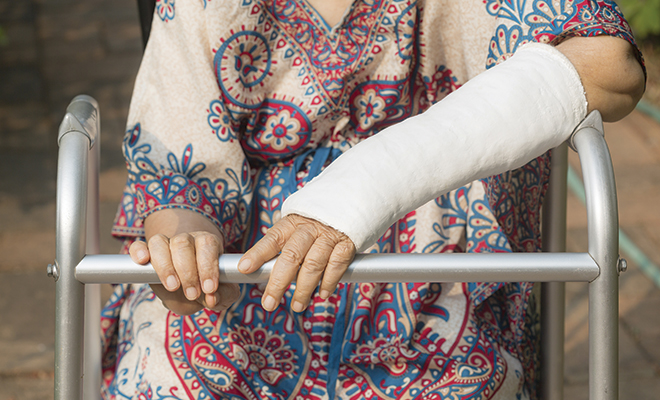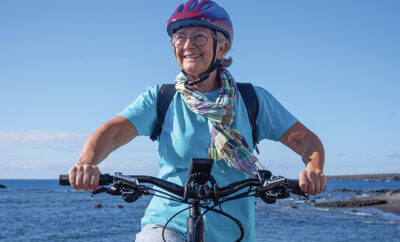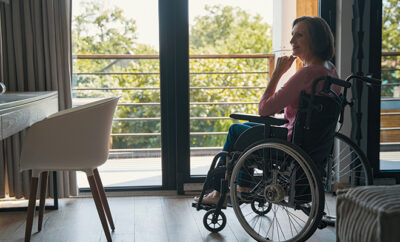
Preventing Fractures as We Get Older
Growing older comes with many blessings, primarily in the form of increased wisdom and experience. Growing older also means anticipating certain physical ailments that arise due to years of wear and tear.
Our bones are no exception. Over the course of one’s life, it is essential to practice good habits in the form of diet and exercise in order to maintain healthy bones. Osteoporosis, which causes an estimated two million fractures a year, is not a normal part of aging and there’s much you can do to protect your bones throughout your life.
The equation for healthy bones is quite simple and involves a protocol of getting enough calcium and vitamin D, consuming a well-balanced diet, engaging in regular exercise and eating foods conducive to bone health. Smoking and drinking excessive alcohol are not going to do your bones any favors. Alcohol can adversely affect your balance and reflexes.
Nevertheless, fractures can and do occur as we age, and it’s important to take steps to reduce their incidence. A simple event, such as tripping on a rug or slipping on a wet floor, can wreak havoc on your life, and a resulting fall can lead to more serious issues, such as a trip to the hospital, extensive injury or even a disability. One in three people 65 or older falls each year, and the older one becomes, the more the risk for falling increases.
The fear of falling becomes more common as people age, even among those who have yet to fall. It can lead people to avoid activities they once enjoyed, such as shopping, walking or just taking part in social activities. However, don’t let the fear of falling stand in the way of your desire to remain active.
Many contributing factors can lead to a fall. Eyesight, hearing and reflexes may not be as sharp as they once were. Diseases such as diabetes, heart issues or thyroid problems can affect your balance. Even certain medications may cause you to feel dizzy or sleepy, thereby increasing the risk of falling. Other causes include safety hazards in your home or community environment.
The good news is, if you take care of your health, you can reduce the chances of falling. Make a commitment to staying physically active and plan an exercise program that’s right for you. Regular exercise is crucial to maintain strong muscles while also keeping your joints, tendons and ligaments flexible. Mild weight-bearing activities such as walking or climbing stairs may slow bone loss from osteoporosis. Consider working with a physical therapist to develop an exercise program tailored specifically for you and make an appointment to have your ears and eyes checked. The smallest of changes in hearing and vision may cause you to fall.
In addition to diet and exercise, strive to create a fall-proof environment in your home. Loss of footing and traction is to blame for many falls. Keep the rooms in your home free of clutter, especially the floors. Your furniture should be easy to walk around, and all walkways should remain clear. Keep floor surfaces as clean as possible and ensure all carpets and area rugs have skid-proof backing or are secured to the floor, including the carpeting on steps. Keep stairways well-lit and make sure there are sturdy handrails on both sides.
In the bathroom, install grab bars on the walls beside the tub, shower and toilet. You can take it one step further and add permanent non-slip strips on the floors of showers and bathtubs for added traction and stability. Light switches should be located near entry points of rooms, so you don’t have to fumble in the dark for the switch. You can also take advantage of technology and defer to voice- or sound-activated lamps.
Additionally, the shoes you wear may not be in your best interest, especially if they are worn out, ill-fitting or just not practical. Invest in some supportive, low-heeled shoes with no-slip soles and avoid walking around the house in socks or stockings.
Be sure to get enough sleep. When you’re tired and sleepy, you are more likely to fall. Further, when standing up from a sitting position, do so slowly. If you get up too quickly, your blood pressure can drop, making you feel wobbly and unsteady. If necessary, use an assistive device to help you feel steady when you walk. The right cane or walker can become your best friend when it comes to preventing falls.
It may seem overwhelming, but it all boils down to developing new and relatively simple habits to ensure your risk of falling is greatly reduced. A conversation with your doctor is a great way to assess your risk of falling and to develop strategies to improve your mobility and prevent injuries. ■
Sources: nof.org, nia.nih.gov and agingcare.com.







